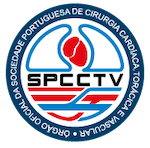COMPLEX CHEST WALL DEFORMITY CAUSING CARDIAC ARREST: A PECULIAR PEDIATRIC CASE
DOI:
https://doi.org/10.48729/pjctvs.17Abstract
Introduction: Congenital chest wall deformities are common in children, causing self and parental concern mainly due to cosmesis. These defects rarely cause severe symptoms in patients.
Case report: 11-year-old girl with a complex chest wall deformity and severe scoliosis causing progressive neurological loss of function. When mobilized to prone position for orthopedic surgery, she suffered sudden hypotension immediately followed by a cardiac arrest, that reverted after moving the child back to supine position. The cardiac arrest was interpreted as a result of a decrease in venous blood return secondary to heart and great vessels compression. She was then proposed and submitted to a modified Ravitch procedure with retrosternal metal bar placement in order to allow ventral positioning. This was successfully achieved, and the patient underwent scoliosis correction 3 months later. After more than a year of follow up, she reduced the need for non-invasive ventilation and tolerates prone positioning.
Conclusion: This case report alerts medical community that beyond cosmesis concerns, severe chest wall deformities can cause life-threatening events if not correctly managed.
Downloads
References
Williams AM, Crabbe DCG. Pectus deformities of the anterior chest wall. Paediatric Respiratory Reviews 2003;4(3):237-42.
Hebra A, Kelly RE, Ferro MM, Yüksel M, Campos JRM, Nuss D. Life-threatening complications and mortality of minimally invasive pectus surgery. Journal of pediatric surgery 2018;53(4):728-32.
Goretsky MJ, Kelly RE, Jr., Croitoru D, Nuss D. Chest wall anomalies: pectus excavatum and pectus carinatum. Adolescent medicine clinics 2004;15(3):455-71.
Li T, Bishop-Rimmer E, Shieh M, Kreiger P, Felberbaum M, Heller M. Pectus excavatum: a cause of serious cardiac dysfunction and dysrhythmia. The American Journal of Emergency Medicine
;33(9):1333.e1-.e2.
Zou J, Luo C, Liu Z, Cheng C. Cardiac arrest without physical cardiac injury during Nuss repair of pectus excavatum. J Cardiothorac Surg 2017;12(1):61-.





